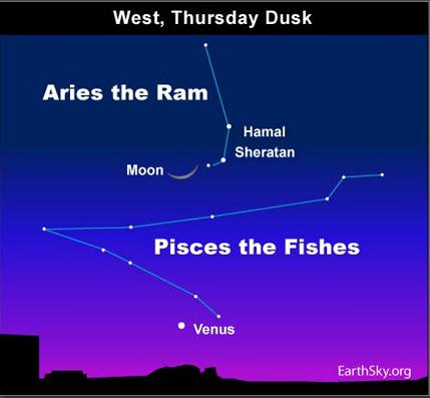Courtesy of EarthSky
A Clear Voice for Science
www.EarthSky.org
Tonight, as soon as it gets dark, the waxing crescent moon can help you locate the small constellation Aries the Ram. Look to the west, just above the place where the sun went down. You will see the thin crescent by the head of the constellation Aries. Although we draw in the constellation Pisces, this faint group of stars is not really visible at this time of year.
Given clear skies, there is no way that you can miss the planet Venus right below the moon. Venus beams as the brightest celestial point of light in the early evening sky. (Keep in mind, though, that Venus sets about 1.5 hours after sunset.) At present, Venus sits in front of the constellation Pisces and will continue to do so till nearly the end of the month. By April, Venus will have passed into the constellation Aries.
Aries is the Ram constellation, and some see the Ram’s horns here. Aries has very few showy stars and is one of the smallest constellations in the skies. Will you see it? Maybe. You might at least see Hamal, otherwise known as Alpha Arietis, the brightest star in Aries.
Aries’ second-brightest star is called Sheratan, or Beta Arietis.
One of the ancient myths related to Aries is that a ram would lead Bacchus and his entourage to water after they were wandering in the Liberian desert for a while. As a reward, Bacchus set the ram under the stars. Therefore, according to this ancient myth, when the sun wanders through Aries, it turns things green and starts to flower on Earth, .
Written by Kelley Knight Heins
Other Links:
Astronomy Picture of the Day from NASA/JPL
The York County Astronomical Society
 Print This Post
Print This Post









